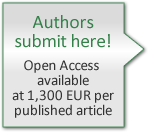Articles
All articles | Recent articles
Experimental and Numerical Investigations of Laser Beam Polishing of Quartz Glass Surfaces
J. Hildebrand1, B. Wittor1, K. Hecht2, J. Bliedtner2, H. Müller3
1 Bauhaus University of Weimar, Faculty of Civil Engineering, Marienstrasse 7A, 99423 Weimar, Germany
2 University of Applied Sciences Jena – Department SciTec, Carl-Zeiss-Promenade 2, 07745 Jena, Germany
3 Günter-Köhler-Institut für Fügetechnik und Werkstoffprüfung GmbH, Otto-Schott-Str. 13, 07745 Jena, Germany
received July 30, 2012, received in revised form January 15, 2013, accepted January 28, 2013
Vol. 4, No. 1, Pages 25-32 DOI: 10.4416/JCST2012-00027
Abstract
The aim of laser beam polishing is to achieve an even surface finish in the shortest possible time without changing the contour of the material. Laser radiation acts as a topology-independent sub-aperture tool. Analyses of influences on the process, interaction between laser radiation and the quartz glass as well as comprehensive evaluation of the results with regard to surface quality, and manipulation of tensions and mechanical properties support the development of an industrially applicable laser polishing technology.
The polishing process was investigated with the commercial FE-software SYSWELD for calculation of the time- and location-dependence of temperature and stress distribution in the plate. The application of the laser beam polishing process requires extensive adaptation of the material models used. The application of simulation is suitable to optimize the process parameters of the targeted temperature and residual stress state.
The design, execution and evaluation of the experiments for laser beam polishing are performed with the help of statistical methods. These show that power and persistence (i.e. dwell time) are the most significant factors. Temperature, as one of the main parameters, is measured accurately either punctually or linearly with a pyrometer and two-dimensionally with an infrared camera. In a defined temperature range a polishing process without stock removal is achievable.
![]() Download Full Article (PDF)
Download Full Article (PDF)
Keywords
Laser beam polishing, stock removal, roughness, numerical simulation, sensitivity
References
1 Hohmann, R., Setzer, M.J.: Building physics formulas and tables, (in German), 3rd edition, Werner-Verlag, Düsseldorf, 1997.
2 Brückner, R.: O.V. Mazurin et. al. In: Handbook of glass data, Part A: Silica glass and binary non silicate oxide glasses. Elsevier, Amsterdam, 1983.
3 Sosmann, R. B.: Bansal, N.P. In: Handbook of glass properties. Academic Press. Inc., Orlando, Florida, 1986.
4 Lucks, D. In: Handbook of glass data. Part A: Silica glass and binary non silicate oxide glasses. Elsevier, Amsterdam, 1983.
5 Men, Ch.: In: Handbook of glass data. Part A: Silica glass and binary non silicate oxide glasses. Elsevier, 1983.
6 Hildebrand, J., Göbel, M., Wittor, B., Werner, F.: Welding and cutting of glass with a laser beam – the potential of numerical simulation, (in German). In: Proceedings of SYSWELD Forum 2009, Weimar, 115 – 129, (2009).
7 Göbel, M., Hildebrand, J., Werner, F.: Advantages of FE-simulation for the development of a welding procedure for quartz glass. In: Proceedings of Glass Performance Days 2007, Tampere, Finland, 733 – 737, (2007).
8 Hildebrand, J.: Numerical welding simulation – determination of temperature, microstructure and residual stress in welded joints of steel and glass materials, (in German). Verlag der Bauhaus-Universität Weimar, 2009.
9 Hildebrand, J., Hecht, K., Bliedtner, J., Müller, H.: Laser beam polishing of quartz glass surfaces, Physics Procedia, 12, 452 – 461, (2011).
Copyright
Göller Verlag GmbH


